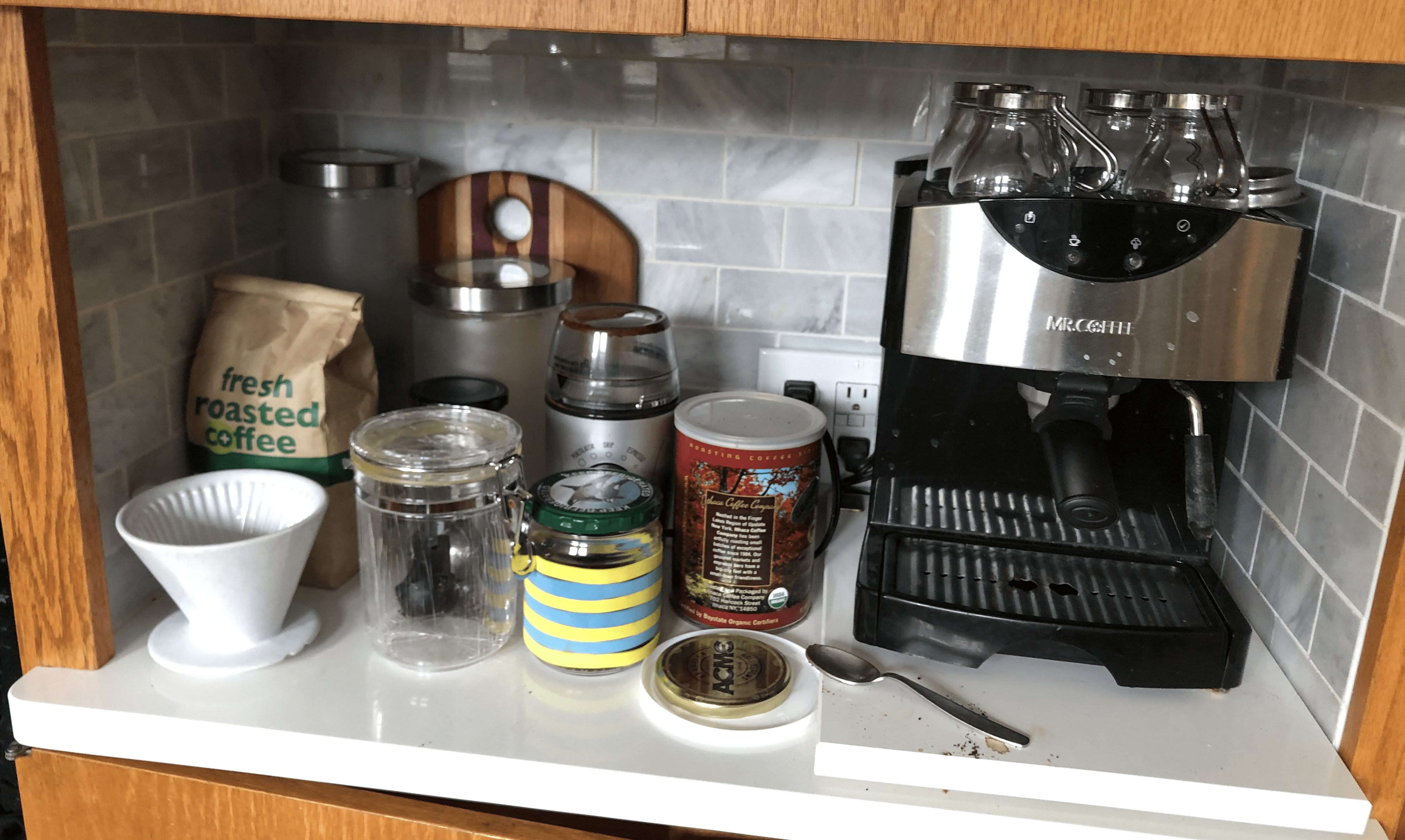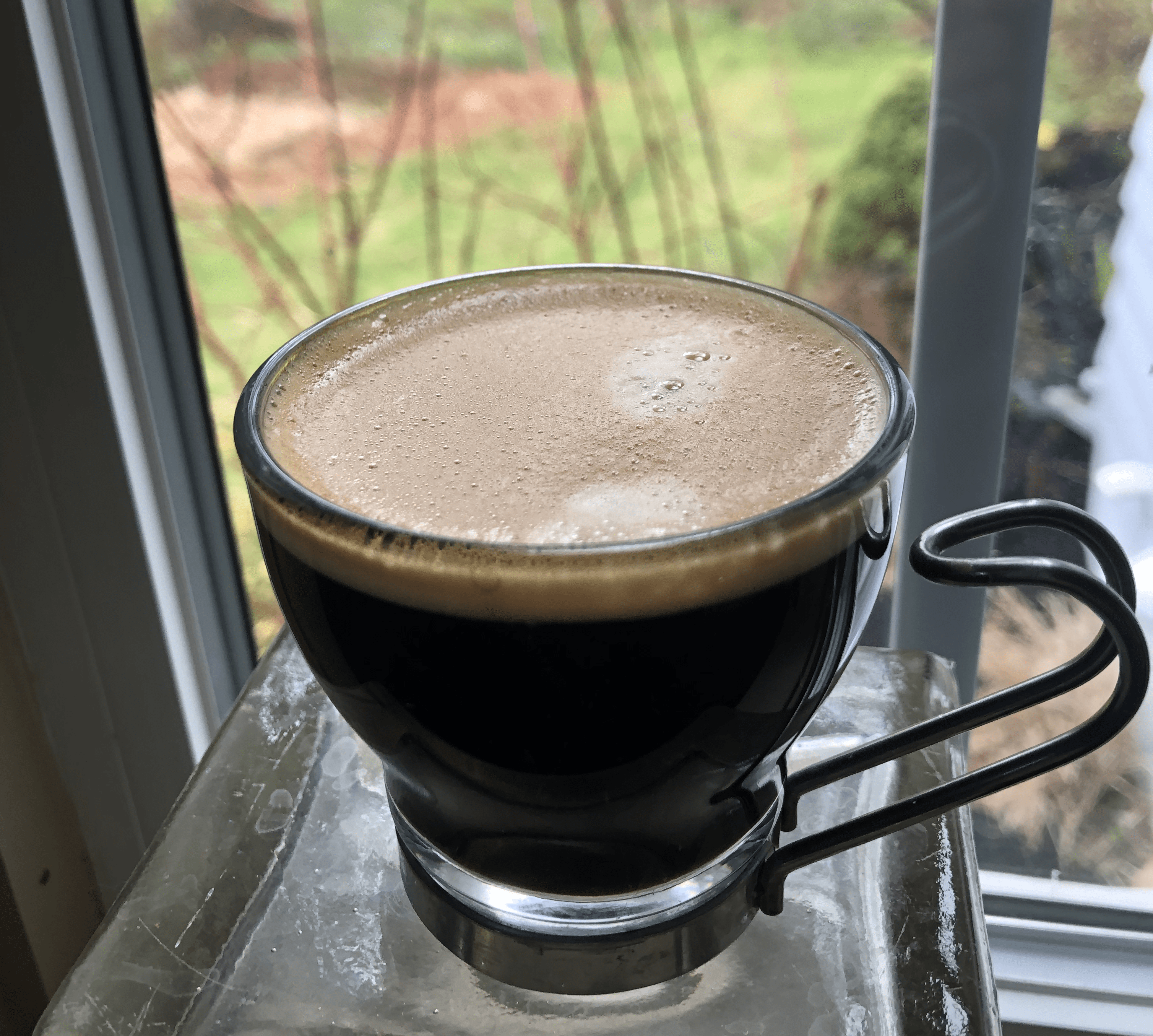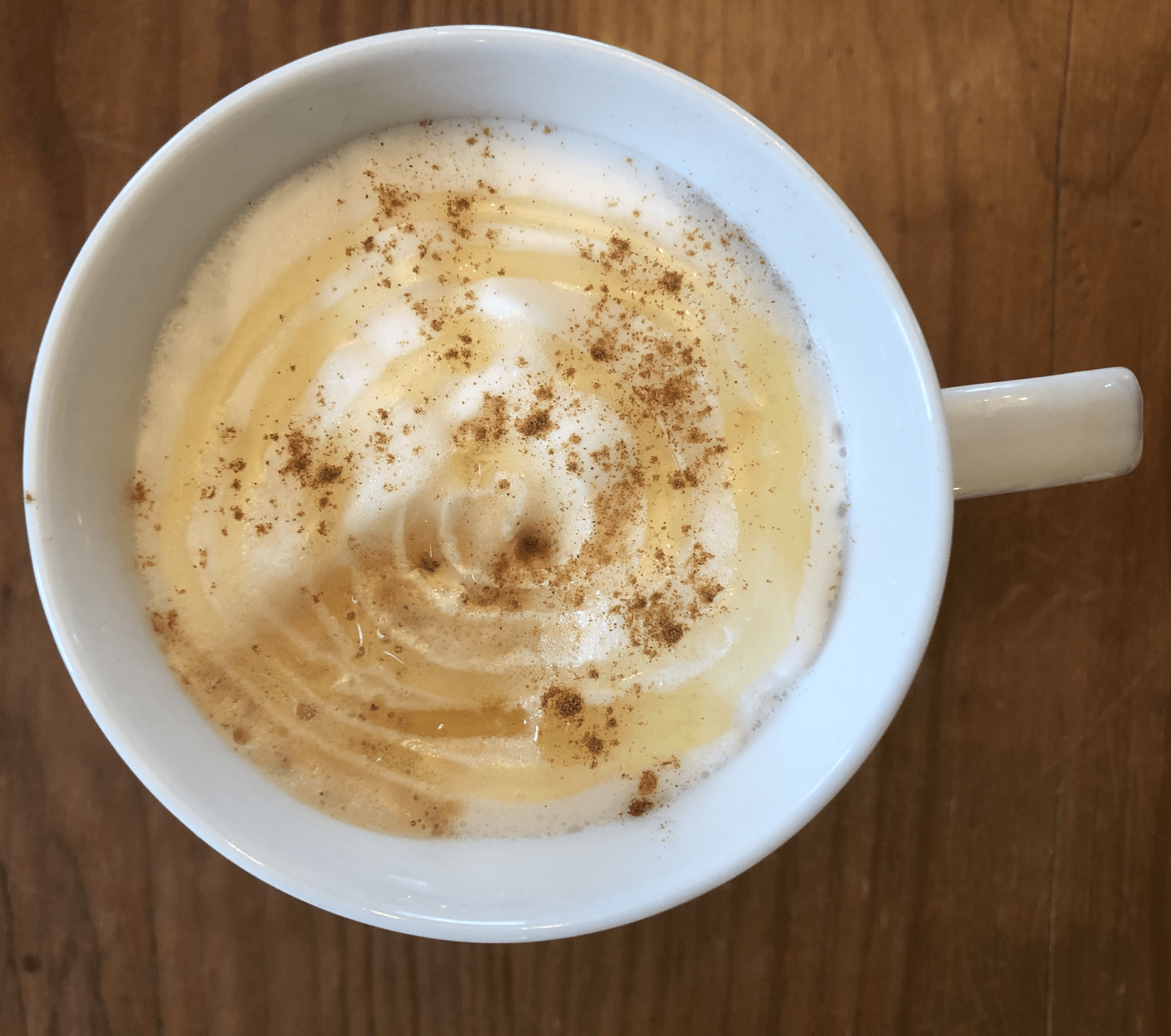Occasionally, someone will say to me, “Toby, I know you drink a lot of coffee, so I was wondering if I could get your advice on what kind of coffee maker I should buy.”
My answer to that question is very long, so I decided that I would like to share it here. You see, the type of coffee I make depends on several factors including, but not limited to, the following considerations: (1) the number of cups of coffee I am currently drinking on an average day; (2) the time of day and the nature of the work ahead of me, or behind me; (3) the number of other potential coffee drinkers that I might share some coffee with; (4) my relationship with those other potential coffee drinkers, including whether or not they are family members or colleagues; (5) the time of year; (6) the day of the week; (7) the amount of time I have to prepare a cup of coffee; and (8) the type of coffee I have available.
Schematic diagram of the different dimensions that I think are worth using to evaluate your coffee, and where each type of device is optimal. For example, if you like the fragrant aromas of high-quality, freshly roasted and freshly-ground beans, then a pour-over system is probably best (section [1]). If you’re interested in sustaining a comfortable level of caffeine intake as you work through the day, but you still would like the beverage to be pleasurable, a pump espresso maker (sec. [2]) or a push-down device (sec. [3]) are both good choices. If you merely want to make a lot of unremarkable coffee to prevent guests or coworkers from suffering from caffeine withdrawal, then read no further: a standard brew system will do just fine (sec. [4]). But, if you are an acerbic, proud, stubborn person who likes to drink caffeinated charcoal sludge that is as bitter as your soul, then I will not try to pry that French Press away from your cold deathly hands (sec. [5]).
By the end of most fall and spring semesters, I am usually drinking about one small cup of coffee or a shot of espresso (roughly 60mg of caffeine) every 90 minutes, although I typically kickstart my day with a larger dose of around 150-200mg of caffeine (either by preparing a strong, large cup or a quad-shot espresso). I began this habit sometime in graduate school, and really amplified it and became more systematic about it during my postdoc at NCAR. And, of course, I refined it once I reached Cornell and had my very own office.
The number of total cups per day usually decreases during the summer, during winter break, and occasionally I have even gone several weeks without caffeine. If I am to estimate the total number of coffees or coffee equivalents over the last 10 years, I would think that four cups per day is a representative average. The math then works out to about 4 x 365 x 10 = 14,600. I do not usually like to drink my coffee with any extra flavors, creams, or sugars, partly because if I did, I would consume an additional 1000 calories per day just to accompany my coffee habit.
I think most people would agree that anything you do 10,000 times is, at some point, worth trying to do well. At least, that is the premise of one of my all-time favorite movies, Groundhog Day. Here, I hope to share some insight I have gained through my quasi-scientific approach to figuring out what I like in a coffee, and, accordingly, what type of device suits those preferences.
[1] My favorite device is a classic and a reliable one: the ceramic pour-over (cost ~$10). Simple, unpretentious, and compact, I could probably be mostly happy most of the time if this were the only type of coffee I made. I like the ceramic ones because the coffee made by plastic ones seems to leave an unpleasant, chemically taste in my mouth. I suspect plastic-making technology has improved since I formed this impression and those chemicals no longer leach out, but I am still skeptical of them. I particularly like the pour-over because it reminds me of my earliest days as a coffee drinker, age 13, Costa Rica, where my family lived for a year during my father’s sabbatical.
Although I start most days with a strong pour-over, sometimes with a bit of half & half or a scoop of canned coconut milk, it has two major drawbacks if you want to drink coffee all day long. First, it requires you to boil water each time you want a cup, which can get tedious over the course of a day. Second, and more critically, it is hard to make a small amount of very strong black coffee and have it be the right temperature when you are done. The pour-over relies on gravity, which in turn means that the water must either flow through the grounds quickly (if they are coarse) or stagnate (if they are finely ground). Under the first scenario, the coffee will not be very strong if you are only trying to make a small amount, while in the second case the stagnant water will cause the coffee to be very strong, but it will also impart a stale, ashy flavor.
[2] In a near tie for first place, my second favorite is the espresso maker ($80 – $40,000+). If you are going to invest in an espresso maker, it is vital that you purchase a machine that pushes steam (instead of hot water) through the coffee grounds. You also need a high-quality grinder for your beans, and you need to buy actual espresso beans, but more on that in the next section.
Until about 10 years ago, most espresso makers were prohibitively expensive (and still today the professional-grade ones that you find in coffee shops run in the $2,000 to $10,000+ range). Naturally, in graduate school––and on my graduate school budget––I learned quickly that you have to be very judicious about where you go to purchase a shot of espresso or a latte. Most coffee shops will produce espresso shots of varying quality throughout the day, depending largely on how busy they are and who is working there. I am sure there are many factors that contribute to and espresso’s quality (or lack thereof), but the cleaning of the machine is an important one. When a coffee shop is very busy, or when the employees are inexperienced or indifferent, the machines will accumulate a nasty residue from all the shots that were made before yours. Since most people order lattes, they don’t notice the horrendous effect this has on the underlying espresso: it becomes astringent and exceedingly unpleasant to drink, even to those of us whose taste buds have become jaded and desensitized from years of abuse.
My wife bought me a Mr. Coffee 2 Shot “Pump” Espresso as a housewarming gift when we moved from Tucson, AZ (where I completed my Ph.D. with Dr. Julia Cole) to Boulder, CO (where I did my Postdoc with the unparalleled Dr. Clara Deser). I still use that machine in my home, and I have one exactly like it in my office at work. It has several advantages over the pour-over system, as well as over its more economical and more expensive rivals. First, if you keep it clean (I try to clean mine at least weekly), you will be able to produce a consistently outstanding espresso. Second, it successfully pumps steam through the espresso, and that same pump can be used to froth milk for making lattes. Evidence of its success comes from the thin crema (the light brown froth on the surface of real espresso) that forms on the surface of every espresso (see picture below). The cheaper ones just pump hot water through the espresso and the resulting fluid tastes like burnt meat. The burnt meat variety was the kind I had in graduate school, and although I used it constantly, I never really liked the espresso that it made. It also could not make crema. The larger, fancier, professional-grade ones might have advantages in the volume of espresso that they can produce over a short period of time, but they cost $500-$2000 or more.
Another strength of an espresso maker is that it will have a steamer, so you can entertain guests–or senior colleagues that you want to impress–by offering to make them a latte. It takes practice to do it well, and I personally don’t like lattes. Fortunately, my wife does. And, while we lived in Boulder, our second child was born, which meant that we were both suffering the excruciating tolls of sleep deprivation over an extended period of time. I was able to cultivate my latte making skills on the weekends during this time by making her a “Boulder Latte”(shown below) (a latte topped with cinnamon and honey) to help jumpstart the mornings.
There are three basic strategies required for steaming milk and generating a sturdy layer of froth that can support the weight of a thick layer of honey. (1) You need to start with cold milk. Make sure the nozzle blows out a small amount of steam before you expose the milk to it. I let my steamer run for about 15-20 seconds before starting to froth the milk. (2) it is imperative that you start steaming from the bottom, yet keep the fluid in motion so that the milk at all depths get exposed to at least some steam. However, focus the majority of your steaming on the bottom. While you are moving the milk around and steaming it, you can tap the base of your steaming container onto a hard surface to pop some of the larger bubbles and create a thicker, sturdier, and denser foam (if your children are sleeping, avoid doing this as it could wake them up). (3) You must prevent over-steaming, which is easiest to do if you have a metal frothing cup because you can keep your hands on the outside of it to continuously measure the temperature. When the metal vase becomes unbearably hot to hold, your steamed milk has reached the right temperature.
A “Boulder” latte, made moments ago for my wife.
I stated before that I don’t like lattes, but if I am starting to get bored with just plain espresso, I will sometimes put a few drops of Half-and-Half into my glass to make a miniature Cafe au lait (see below).
One slight drawback of my pump espresso maker is that it is a little loud. When I first came to Cornell as a newly minted assistant professor, it made me very self-conscious to be running the thing every 90min in Bradfield Hall’s 11th floor and it’s paper-thin walls. Also, my machine has a removable 40 oz water reservoir attached to the back, which is very convenient for an office space because it obviates the need for a proximate source of running water. But, it can also be a drag to refill the reservoir before you’ve actually had your coffee.
The biggest disadvantage of the espresso machine is that it is too easy to make a lot of coffee. This can lead to overconsumption, jitters, irritability, insomnia, workaholism, run-on sentences, high blood pressure, cardiac disease, and premature death. If you experience any of these symptoms or other side effects, tell your doctor immediately.
[3] Recently, I have begun using a push-down (AeroPress) device (~$30). It uses hot water and works like a French Press turned upside down. However, with practice and a little bit of technique, this device can combine the best aspects of both drip coffee and espresso. You can use very finely ground beans, which will ensure that your coffee is strong. Yet, because it relies on pressure from your hand, not gravity, the water will move quickly through those grounds, so you avoid the problem of the water stagnating and compromising the coffee’s flavor. If you are very skilled, you can even put in just enough air behind the hot water to push gas through the device, which will make a pseudo crema. I have yet to master this technique, but I’ve seen U. of AZ’s Kiyomi Morino execute it perfectly. The push-down device also works for any type of coffee you might wish to consume–light roast, dark roast, espresso, ground beans, and (gag) flavored coffee. The filters are not expensive, and there are reusable ones. So, I think overall, if you are a graduate student or postdoc and you want something lightweight, portable, and inexpensive, this is probably a very good choice.
I don’t have any real objections to this method of making espresso, except that it is kind of boring and a little slower than the espresso maker. Of course, that’s the point, in my case. I actually purchased my AeroPress as a tenure gift to myself along with a burr hand grinder so that I would slow down the rate at which I was consuming caffeine. After I did, I also realized that it was worth paying a little extra for a high-quality grinder for the beans. The cheaper ones don’t last very long and they generate a lot of heat while they do the grinding, which releases aromatics prematurely from the coffee and diminishes its quality. The best kind of grinder actually grinds the beans with a burr (instead of blending them, as most plug-in devices do), so that the subtle fragrances of your coffee end up in your nostrils when you drink the beverage.
At work, I have a wonderful (and therapeutic) hand-held burr grinder that also helps slow down my rate of consumption. It further gives me a mental break every 90 minutes or so because I have to use both hands to do the grinding. During that break, I walk away from my standing desk, sit down, and try to avoid my computer screen. Sometimes I even try to stretch while grinding. Even if I don’t do anything else, I find it relaxing to use my fingers and opposable thumbs for something other than typing and clicking; the burr grinder satisfies some deeply human need to use tools with our hands.
[4] I dust off the very unremarkable Brew Coffee Maker in my basement when I work from home and we have house guests (remember those days, before COVID?). I think this device is purely practical and not very exciting. It’s like a bus or a commuter train: it will get you from point A to point B (e.g., from groggy to alert) without much hassle or charm. I use it when we have house guests for two reasons. First, I can load it up in the evenings when I go to bed, then set it to start brewing at 5:45am so that I drink my first coffee before everyone else is awake (I believe this choice is now called “self-care”). Second, it easily produces enough coffee for everyone who drinks coffee, which really saves a lot of time, as compared to making individual lattes or espressos for more than 3-4 people, or even pour-over coffees for that number.
[5] Finally, during the summer, I make cold-brewed coffee with a French Press. Normally, I hate French Presses because they make gritty, nasty coffee that tastes like someone dumped charcoal into an oil slick, then poured that mixture into my coffee before dousing their burning cigarette into it. They are also annoying and messy to clean, in addition to being pretentious and unnecessary. If you are an avid fan of the French Press, I do not mean to offend you personally, but I invite you to take the following challenge: Please make your finest possible French Pressed coffee by whatever means you think are optimal. Then, drink it without any milk, sugar, honey, or additional flavor and ask yourself this: do I really like how this tastes, or do I just like the idea of this piece of equipment because the word “French” makes me feel sophisticated?
I suspect that this test will cause many of you to break up with that French Press that you bought for $8.00 at Target when you were in your early 20s. Think of it like a college relationship that just needed to end because neither one of you could grow to your fullest potential if you stayed together.
If you really are committed to your French Press, and you are determined to find a way to love it in spite of its many, many flaws, then it can be a very valuable device for making some of the best possible iced coffee. You simply put cold water into the device and leave it in the fridge overnight, then it can make a very refreshing beverage that you might enjoy plain, over ice, with a touch of whole milk, milk alternatives, or ice-cream the next day. If you live in a hot climate, or if you are concerned about climate change, or if you are afraid the current COVID crisis will lead to widespread power outages, then you probably should hang onto that French Press after all, since it could be your best friend for coping with the times ahead.







